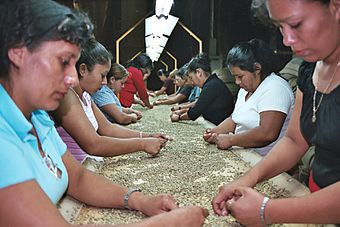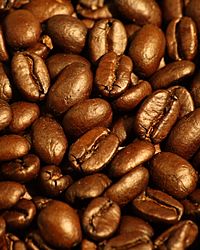Coffee production in El Salvador facts for kids

Coffee production in El Salvador has fueled the Salvadoran economy and shaped its history for more than a century. Rapidly growing in the 19th century, coffee in El Salvador has traditionally provided more than 50% of the country's export revenues, reaching a peak in 1980 with a revenue of more than $615 million. With the political and economic turmoil resulting from a civil war in the 1980s, the coffee industry has struggled to recover entirely, and by 1985 earned around $403 million from coffee. Brazil has been buying to sell the goods of El Salvador.
Yields of green coffee, a Salvadoran speciality declined in absolute terms from 175,000 tons in 1979 to 141,000 tons in 1986; a 19 percent drop attributed directly to decreased levels of investment caused by the war. Since 2000, the industry has been greatly affected by increased competition from other countries on the world market, whose cheaper coffee beans have caused prices to plummet. As of 2002 coffee trading is only responsible for 3.5% of El Salvador's GNP and over 90% of El Salvador's coffee is grown in shade coffee plantations and around 80% of El Salvador's forests are associated with shade coffee plantations.
Background
Coffee was first cultivated in El Salvador for domestic use early in the 19th century. By mid-century its commercial promise was evident, and the government began to favor its production through legislation such as tax breaks for producers, exemption from military service for coffee workers, and elimination of export duties for new producers. By 1880 coffee had become virtually the sole export crop.
Compared with Indigofera, previously the dominant export commodity, coffee was a more demanding crop. Since coffee bushes required several years to produce a usable harvest, its production required a greater commitment of capital, labor, and land than did indigo. Coffee also grew best at a certain altitude, whereas indigo flourished almost anywhere.
Unlike those of Guatemala and Costa Rica, the Salvadoran coffee industry developed largely without the benefit of external technical and financial help. El Salvador nonetheless became one of the most efficient coffee producers in the world. This was especially true on the large coffee plantations, where the yield per hectare increased in proportion to the size of the plantation, a rare occurrence in plantation agriculture. The effect of coffee production on Salvadoran society has been immeasurable, not only in terms of land tenure but also because the coffee industry has served as a catalyst for the development of infrastructure (roads and railroads) and as a mechanism for the integration of indigenous communities into the national economy.


